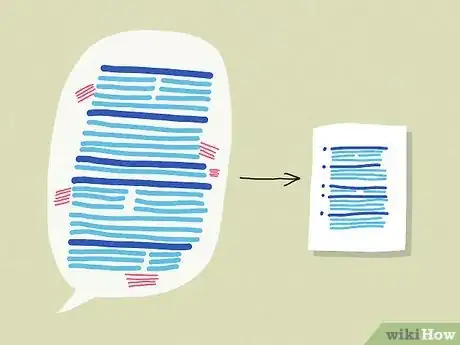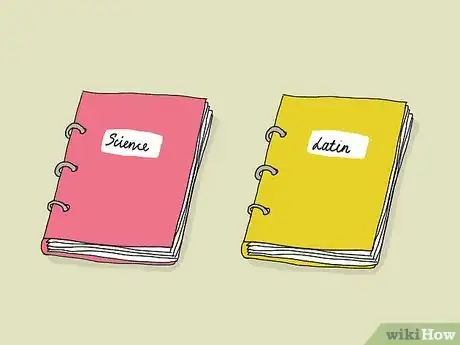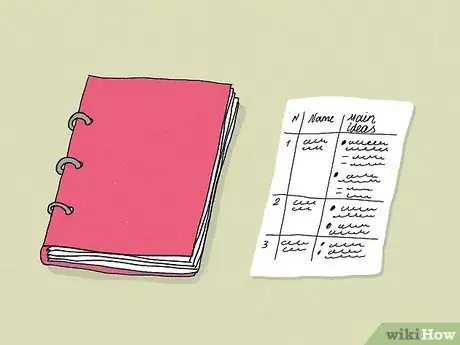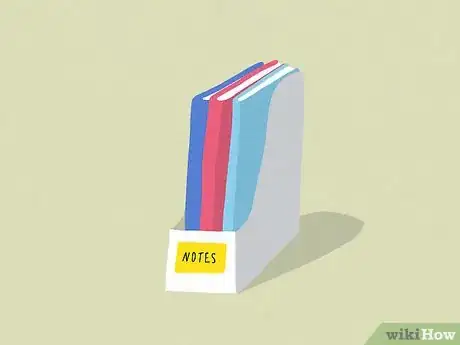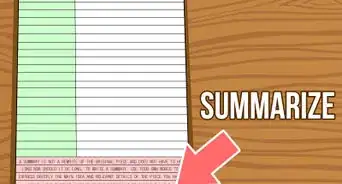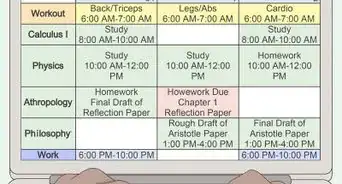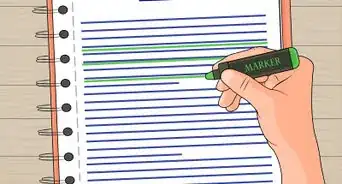This article was co-authored by David Jia. David Jia is an Academic Tutor and the Founder of LA Math Tutoring, a private tutoring company based in Los Angeles, California. With over 10 years of teaching experience, David works with students of all ages and grades in various subjects, as well as college admissions counseling and test preparation for the SAT, ACT, ISEE, and more. After attaining a perfect 800 math score and a 690 English score on the SAT, David was awarded the Dickinson Scholarship from the University of Miami, where he graduated with a Bachelor’s degree in Business Administration. Additionally, David has worked as an instructor for online videos for textbook companies such as Larson Texts, Big Ideas Learning, and Big Ideas Math.
There are 7 references cited in this article, which can be found at the bottom of the page.
wikiHow marks an article as reader-approved once it receives enough positive feedback. This article received 15 testimonials and 80% of readers who voted found it helpful, earning it our reader-approved status.
This article has been viewed 356,804 times.
Taking notes and keeping them organized is an important part of the schooling and the work worlds. You'll need organized notes for studying, writing essays, keeping track of work decisions, and your assignments. Keeping them organized will not only help you with these tasks, but it will also help you remember your material easily. In this wikiHow, you will learn how to keep track of and organize your notes.
Steps
Organizing Notes for Class
-
1Take good notes. One of the keys to having your notes organized is to make sure you're taking good notes. This means that you only write down the really important things and don't take down every single thing your instructor says (unless it's really funny, of course).[1]
- Note down things that the instructor says more than once. Reiterating points is a way of highlighting what the most important material is going to be. Anything that's repeating is probably going to end up on a test or at least be important to understanding the class.
- Don't write down things you already know—the more you have in your notes, the harder it will be to find the really important things when you're studying.[2]
- Be selective (don’t take down every single note): take down the main points of the lecture or discussion; write down examples or hypotheticals, especially in math and science classes.
- A piece of information usually has a main idea and supportive details, which can also be very important, but the main idea is definitely something worth noting. In paragraphs, the main idea is usually either the first or the last sentence. In good presentations, the bullet points on the slides are often main ideas.
-
2Mix different styles of note-taking. There are lots of different ways of recording information. You can use one style or a mix of a few. The mix is best, because usually you can acquire more information and in different ways.[3]
- Handwritten notes work best for classes that have to do with: numbers, equations, and formulas–calculus, chemistry, physics, economics, symbolic logic, also language classes because helps you memorize/remember more effectively.
- You can also record the lecture or discussion, if your instructor allows you to do so. This is great for allowing you to go back and listen to very specific parts of the lecture, although it can be harder to make information stick in your memory.
- Make sure you collect any lecture notes and power-point slides that your instructor makes available. These can be valuable notes for essays and exams.
Advertisement -
3Figure out which note-taking method works best for you. There are different ways to take down notes, some of which are more effective than others at helping you to stay organized or get organized later. You'll need to experiment to see which methods work best for you.[4]
- An effective method is the Cornell method of note-taking. On the left-hand side of the paper mark a two- and one-half inch column (6.35 cm). On the right side have a column six inches across (15.24 cm). You'll use the right-hand column to take notes during your class or lecture. After the lecture, you'll summarize your notes, designate keywords, and create questions about the material in the left-hand column.
- A lot of people use the rough outline method. This basically means writing down the main points of the lecture or class (you can format them as a list of bullet points, for example). After class, write your summary of the notes in a different colored pen, or highlight it.
- Mind mapping is a more visual and creative form of taking notes. You draw your notes, rather than writing down sentences in a linear format. Write the main topic of the lecture or class in the center of a piece of paper. Each time the instructor makes a new point, write those around the central topic. Draw lines to connect different ideas. You can also draw images rather than writing words.
- Another method, known as Split Page Method, is more space-consuming than Cornell notes, but easier to study later. A page is divided into two columns: one for main and the other for secondary ideas.
-
4Store your notes in one place. If you're storing your notes all over the place it's going to make it very difficult to organize them for exams and essays when the time comes. Don't just write your notes down in whatever notebook you happen to have nearby or you're never going to find those notes again.
- Separate your notes by subject. You don't want to mix up your physics notes with your algebra notes!
- On your computer, make sure that you have one folder for your notes from each different class. If you put them all together it's going to be difficult to find them again.
- It's usually easier to store any handwritten notes in a binder, because you can add and subtract pages as needed without having to tear them out.
-
5Keep track of your hand-outs and syllabi. A lot of people (especially freshman university students) don't realize how important syllabi and hand-outs are going to be. These have information you're going to need to know (like homework assignments, the purpose of the class, and so on).
- These will also usually detail information about the types of essays and information you're going to need to know which can be useful for what kinds of notes you take in class.
- Keep all the syllabi and hand-outs for each class in the same place as your notes so that they are easily accessible, especially when your instructor brings up information on them in class.
-
6Have a separate notebook or binder for each class. You really do need to keep everything in the same place. This makes it easier for you to locate it when you need it. If you have a distinct folder for each class you will know exactly where your notes are.[5]
- Make sure you keep these different notebooks and binders handy. It isn’t much use to you if you don’t keep putting class notes in the right place.
- The more specific you are, the better. This means that for one class you might create different folders for the different parts of the class. As an example: if you had a film class split into four parts, you might have a different notebook for each part of the class.
- As another example: you have different folders for each section of the class (for Latin class you have a different folder for each different part of speech [nouns, verbs, indirect clauses, etc.]).
-
7On a computer have separate folders for each class. If you keep all your notes on your computer, make sure that even there you have separate spaces for your notes. You don't want to have to back through and dig through your computer files.
- Have folders in those folders for particular information. For example: you have the main folder that's for your Ancient Astronomy class, but inside you have specific folders for the different sections of the class, as well as for the two essays you have to write.
- As another example, you might have a folder for your research paper, a folder for your information about gender identity politics in your gender studies class.
-
8Create a master outline of notes for each class. This may sound like overkill, but it can be really helpful for you to know what notes you have. You only need to cover the most basic ideas that each group of notes has (the very main ideas) but it'll make it easier to go back through it.[6]
- Combine lecture and reading notes into coherent whole. Figure out main ideas and how they relate. For example: if your class is about Medieval women, the main ideas might be about formation of self, types of writings, notions of autonomy and gender, and so on. You might show how these ideas relate to one another.
- Make sure that you've covered the most important points, as well as the sub-points that support the main points.
-
9Stay consistent. You don't want to have to keep trying to figure out how and where you recorded certain information. This will make your organization more difficult in the long run. If you keep to one way of recording notes and specific places for each class, you'll be much more prepared than otherwise.
- Giving yourself some slack on organization will mean that you won’t maintain your organization and it will be more difficult come exam time or essay time.
Organizing Notes for a Meeting
-
1Take effective notes during meetings. You don't want to write down every single thing that people say, unless you're taking very specific minutes. When you're in a meeting, you want to make sure you only have the most important things that come up.[7]
- Especially, make sure that you note down to-do items, decisions that are made, and anything that needs to be followed up on.
- Take notes on paper and copy them onto the computer later on, this will help you remember what was said.
- An effective method is the Cornell method of note-taking. On the left-hand side of the paper mark a two- and one-half inch column (6.35 cm). On the right side have a column six inches across (15.24 cm). You'll use the right-hand column to take notes during your meeting. After the lecture, you'll summarize your notes, designate keywords, and create questions about the material in the left-hand column.
-
2Make sure you’ve recorded the appropriate information. There are some very specific things you'll need to mark down, along with what was said in the meeting. This is particularly important if you're going to have to send these notes out to everyone at the meeting afterwards.[8]
- Make sure you've noted down the date, the name of the organization, the purpose of the meeting, and the people attending (as well as any people who were absent who should have been there).
-
3Summarize your notes/the meeting afterwards. You will need to synthesize the most important material to make sure you know what needs to happen and what was decided.
- Put a different colored box around the summary so that it is easily readable.
- Summarize don’t transcribe. You do not need every single detail of what was said. For example: you only need to say that it was decided to order a new item of office equipment, rather than the long discussion about the best types of binding machine.
-
4Make sure you’re organizing with the most important information. You don't want to try to organize all the different types of stationery (according to the above example), you only want to say that a new stationery is needed and perhaps what kind has been decided on.[9]
- The most important things you need to make sure you have are: actions, decisions, and reference information.
- Highlight the most important information or leave a margin for keywords and most important ideas.
- Avoid trying to organize during the meeting. Doing that later will help you remember things and will make sure you don’t miss important material.
-
5Have separate folders for each meeting. You want to make sure that the material doesn’t get all bundled up together and subsequently lost in the shuffle. Do this by making sure each meeting is separately marked, or designated.
- Or you can have all the same types of meetings together. For example: if you keep notes on your weekly meeting with your supervisor, you would keep those separate from the notes you keep on the weekly meeting with your entire group.
-
6Organize in chronological order. In keeping your meeting notes together you want to make it easy to go back through and see when certain decisions were made, who wasn't at a certain meeting and therefore needs the information, and so on.
-
7Keep your notes in the same place. This way you won't have to be skittering about the office after your meeting trying to find your notes. Or you won't have to worry about getting the notes out on time to the whole group because you couldn't locate them.
Expert Q&A
Did you know you can get expert answers for this article?
Unlock expert answers by supporting wikiHow
-
QuestionHow do you organize notes for multiple classes?
 David JiaDavid Jia is an Academic Tutor and the Founder of LA Math Tutoring, a private tutoring company based in Los Angeles, California. With over 10 years of teaching experience, David works with students of all ages and grades in various subjects, as well as college admissions counseling and test preparation for the SAT, ACT, ISEE, and more. After attaining a perfect 800 math score and a 690 English score on the SAT, David was awarded the Dickinson Scholarship from the University of Miami, where he graduated with a Bachelor’s degree in Business Administration. Additionally, David has worked as an instructor for online videos for textbook companies such as Larson Texts, Big Ideas Learning, and Big Ideas Math.
David JiaDavid Jia is an Academic Tutor and the Founder of LA Math Tutoring, a private tutoring company based in Los Angeles, California. With over 10 years of teaching experience, David works with students of all ages and grades in various subjects, as well as college admissions counseling and test preparation for the SAT, ACT, ISEE, and more. After attaining a perfect 800 math score and a 690 English score on the SAT, David was awarded the Dickinson Scholarship from the University of Miami, where he graduated with a Bachelor’s degree in Business Administration. Additionally, David has worked as an instructor for online videos for textbook companies such as Larson Texts, Big Ideas Learning, and Big Ideas Math.
Academic Tutor
-
QuestionHow do I keep my notes organized?
 David JiaDavid Jia is an Academic Tutor and the Founder of LA Math Tutoring, a private tutoring company based in Los Angeles, California. With over 10 years of teaching experience, David works with students of all ages and grades in various subjects, as well as college admissions counseling and test preparation for the SAT, ACT, ISEE, and more. After attaining a perfect 800 math score and a 690 English score on the SAT, David was awarded the Dickinson Scholarship from the University of Miami, where he graduated with a Bachelor’s degree in Business Administration. Additionally, David has worked as an instructor for online videos for textbook companies such as Larson Texts, Big Ideas Learning, and Big Ideas Math.
David JiaDavid Jia is an Academic Tutor and the Founder of LA Math Tutoring, a private tutoring company based in Los Angeles, California. With over 10 years of teaching experience, David works with students of all ages and grades in various subjects, as well as college admissions counseling and test preparation for the SAT, ACT, ISEE, and more. After attaining a perfect 800 math score and a 690 English score on the SAT, David was awarded the Dickinson Scholarship from the University of Miami, where he graduated with a Bachelor’s degree in Business Administration. Additionally, David has worked as an instructor for online videos for textbook companies such as Larson Texts, Big Ideas Learning, and Big Ideas Math.
Academic Tutor
-
QuestionHow do I take better notes?
 David JiaDavid Jia is an Academic Tutor and the Founder of LA Math Tutoring, a private tutoring company based in Los Angeles, California. With over 10 years of teaching experience, David works with students of all ages and grades in various subjects, as well as college admissions counseling and test preparation for the SAT, ACT, ISEE, and more. After attaining a perfect 800 math score and a 690 English score on the SAT, David was awarded the Dickinson Scholarship from the University of Miami, where he graduated with a Bachelor’s degree in Business Administration. Additionally, David has worked as an instructor for online videos for textbook companies such as Larson Texts, Big Ideas Learning, and Big Ideas Math.
David JiaDavid Jia is an Academic Tutor and the Founder of LA Math Tutoring, a private tutoring company based in Los Angeles, California. With over 10 years of teaching experience, David works with students of all ages and grades in various subjects, as well as college admissions counseling and test preparation for the SAT, ACT, ISEE, and more. After attaining a perfect 800 math score and a 690 English score on the SAT, David was awarded the Dickinson Scholarship from the University of Miami, where he graduated with a Bachelor’s degree in Business Administration. Additionally, David has worked as an instructor for online videos for textbook companies such as Larson Texts, Big Ideas Learning, and Big Ideas Math.
Academic Tutor Take really precise notes on what you're learning in class that you wouldn't already know. If you write down everything the teacher says, it will take forever to go back through the notes to find the information you need. On the other hand, if you don't take enough notes, you'll have to go back and re-read the textbook when it's time to study.
Take really precise notes on what you're learning in class that you wouldn't already know. If you write down everything the teacher says, it will take forever to go back through the notes to find the information you need. On the other hand, if you don't take enough notes, you'll have to go back and re-read the textbook when it's time to study.
Warnings
- It's best to strike a balance between taking too many notes and taking too few. You'll only really get a feel for this if you experiment and see what works best for you.⧼thumbs_response⧽
References
- ↑ https://learningcenter.unc.edu/tips-and-tools/effective-note-taking-in-class/
- ↑ David Jia. Academic Tutor. Expert Interview. 7 January 2021.
- ↑ https://learningcenter.unc.edu/tips-and-tools/effective-note-taking-in-class/
- ↑ https://www.murdoch.edu.au/news/articles/the-art-of-note-taking-what-s-really-most-effective
- ↑ David Jia. Academic Tutor. Expert Interview. 7 January 2021.
- ↑ https://learningcenter.unc.edu/tips-and-tools/taking-notes-while-reading/
- ↑ http://www.smead.com/hot-topics/organized-meeting-minutes-1412.asp
- ↑ https://www.resourcecentre.org.uk/information/taking-minutes/
- ↑ https://www.resourcecentre.org.uk/information/taking-minutes/
About This Article
No matter what type of notetaking you use, you should never write down everything that your professor or boss says. Instead, focus on the main details and key points. Try out various note-taking styles to find what works best for you, like the Cornell method. To use the Cornell method, split each page into sections for note taking, questions, and a summary. Or, you can try the split-page method and divide your page into columns, one for the main ideas and the other for secondary ideas. For more information, like how to store your notes, read on!
